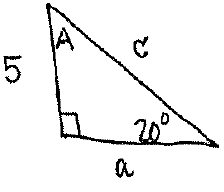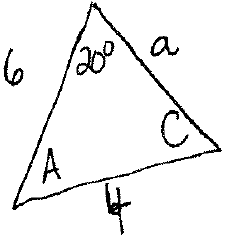Solve for $A$ in the $C=30.87$ triangle
Use the fact that the sum of angles in a triangle is $180^{\circ}$ to see
$$20^{\circ} + 30.87^{\circ} + A = 180^{\circ}.$$
Therefore
$$A = 180^{\circ} - 20^{\circ} - 30.87^{\circ} = 129.13^{\circ}.$$
Solve for $a$ in the $C=30.87$ triangle
By the law of sines,
$$\dfrac{\sin\left(129.13^{\circ} \right)}{a}= \dfrac{\sin \left( 20^{\circ} \right)}{4},$$
so
$$a = \dfrac{4\sin \left( 129.13^{\circ} \right)}{\sin \left(20^{\circ} \right)}.$$
Solve for $A$ in the $C=149.13$ triangle
Use the fact that the sum of angles in a triangle is $180^{\circ}$ to see
$$20^{\circ} + 149.13^{\circ} + A = 180^{\circ}.$$
Therefore
$$A = 180^{\circ} - 20^{\circ} - 149.13^{\circ}=10.87^{\circ}.$$
Solve for $a$ in the $C=149.13$ triangle
By the law of sines,
$$\dfrac{\sin \left( 10.87^{\circ} \right)}{a} = \dfrac{\sin(20^{\circ})}{4},$$
so
$$a = \dfrac{4 \sin \left( 10.87^{\circ} \right)}{\sin(20^{\circ})}.$$
Section 4.2 #32: Solve the triangle given by the information $a=3$, $b=7$, and $A=70^{\circ}$.
Solution: First draw the triangle:
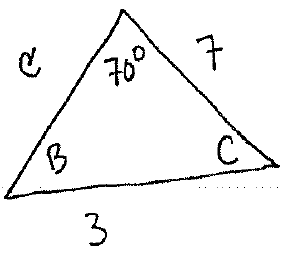 Find $B$
Find $B$
By the law of sines we see
$$\dfrac{\sin(B)}{7} = \dfrac{\sin(70^{\circ})}{3}.$$
Therefore
$$\sin(B) = \dfrac{7\sin(70^{\circ})}{3} = 2.19.$$
But we may not take $\sin^{-1}$ of $2.19$ (it is too big) and so this triangle does not exist.
Section 4.3 #15: Solve the triangle given by the information $a=9$, $b=6$, and $c=4$.
Solution: First draw the triangle:
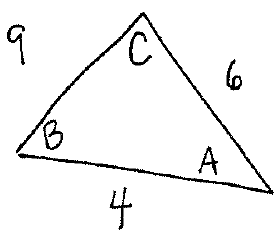
We have no choice other than to use the law of cosines to solve for the angles.
Solve for $A$
Using the law of cosines, we see
$$9^2 = 6^2 + 4^2 - 2(6)(4)\cos(A).$$
This means
$$81 = 36 + 16 - 48\cos(A).$$
Isolating $\cos(A)$ gives us
$$\cos(A) = \dfrac{-29}{48}.$$
Therefore take $\cos^{-1}$ to isolate $A$:
$$A = \cos^{-1} \left( -\dfrac{29}{48} \right) = 127.2^{\circ}.$$
Solve for $B$
Using the law of cosines, we see
$$6^2 = 9^2 + 4^2 - 2(9)(4)\cos(B).$$
Simplifying yields
$$36 = 81 + 16 - 72\cos(B).$$
Isolating $\cos(B)$ yields
$$\cos(B) = \dfrac{-61}{-72}.$$
Therefore take $\cos^{-1}$ to get
$$B = \cos^{-1} \left( \dfrac{-61}{-72} \right) =32.09^{\circ}.$$
Solve for $C$
We will use the fact that the sum of the angles in a triangle is $180^{\circ}$. This yields
$$127.2^{\circ} + 32.09^{\circ} + C = 180^{\circ},$$
so
$$C = 180^{\circ}-127.2^{\circ} - 32.09^{\circ} = 20.71^{\circ}.$$
NOTE: you can solve this any way you wish, you may get slightly different answers depending on what angles you solve for first/etc -- you may also just use the law of cosines three times instead of using the sum of angles formula
Section 4.3 #20: Solve the triangle given by the information $a=6$, $b=4$, and $C=60^{\circ}$.
Solution: First draw the triangle:
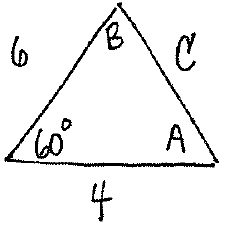
Solve for $c$
Using the law of cosines,
$$c^2 = 6^2+4^2-2(6)(4)\cos \left( 60^{\circ} \right),$$
so
$$c= \sqrt{52-48\cos \left( 60^{\circ} \right)} = 5.29.$$
There are two missing angles. We will use the law of cosines to find one of the missing angles and then use the sum of the angles equalling $180^{\circ}$ to find the third.
Find $B$
Using the law of cosines,
$$4^2 = 6^2 + 5.29^2 - 2(6)(5.29)\cos \left( B \right),$$
yielding
$$\dfrac{-47.98}{-63.48} = \cos(B),$$
so take $\cos^{-1}$ of each side to get
$$B = \cos^{-1} \left( \dfrac{-47.98}{-63.48} \right)=40.9^{\circ}.$$
Find $A$
$$A = 180^{\circ} - 60^{\circ} - 40.9^{\circ} = 79.1^{\circ}.$$



